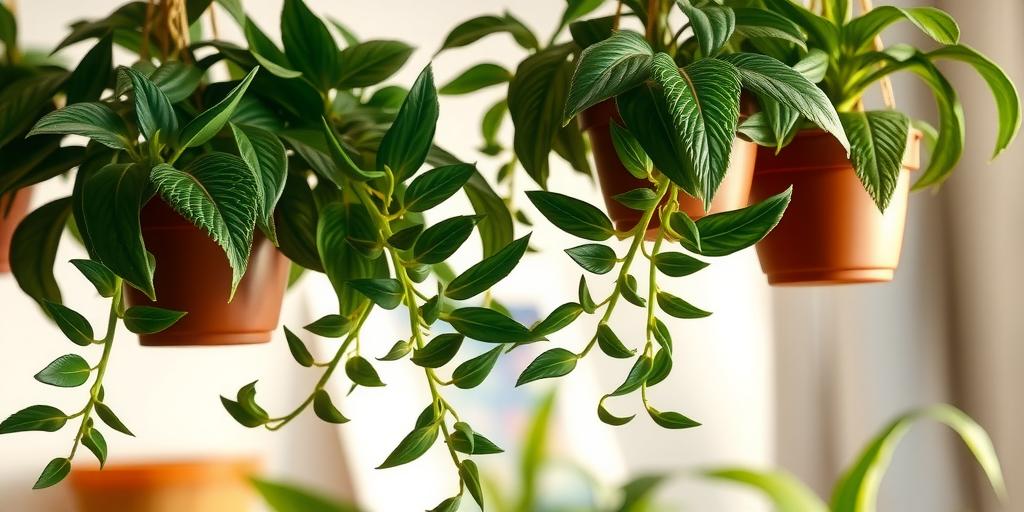
Best Low Light Hanging Plants Safe For Pets and Kids (2025)
Discover the best low-light hanging plants that are safe for pets and kids! Perfect for indoor spaces with minimal sunlight—non-toxic, easy to care for, and stylish.
Introduction
Did you know that over 65% of households own at least one pet or have young children? If you’re a plant lover, finding greenery that thrives in low light and is safe for your furry friends and little ones can be a challenge. But don’t worry—we’ve got you covered! In this guide, we’ll explore the best pet- and kid-friendly hanging plants that flourish even in dim corners. Whether you’re sprucing up a shady balcony or a cozy living room, these plants will bring life to your space without the worry.
Why Choose Low Light Hanging Plants Safe For Pets and Kids?
Benefits of Hanging Plants in Small Spaces
Hanging plants are a fantastic solution for small spaces where floor or shelf space is limited. They add greenery without taking up valuable real estate, making them perfect for apartments, tiny homes, or rooms with minimal surface area. Plus, they create visual interest by drawing the eye upward, making ceilings feel higher and rooms more spacious.
Importance of Non-Toxic Plants for Households with Pets and Children
If you have curious pets or little ones who love to explore, choosing non-toxic plants is a must. Many common houseplants can be harmful if ingested, causing anything from mild stomach upset to severe poisoning. By selecting pet- and kid-safe varieties, you can enjoy the beauty of indoor plants without worrying about accidental nibbles.
How Low-Light Plants Improve Indoor Air Quality
Low-light hanging plants aren’t just decorative—they also help purify the air. Many of these plants filter out common indoor pollutants like formaldehyde and benzene, which can come from furniture, cleaning products, and even paint. Even in dimly lit spaces, they contribute to fresher, cleaner air, making your home healthier for everyone.
Top Pet & Kid-Safe Low Light Hanging Plants
Spider Plant – Hardy, Air-Purifying, and Completely Safe
Spider plants are a classic choice for hanging baskets. They’re incredibly resilient, thrive in low to moderate light, and are completely non-toxic to pets and kids. Plus, they produce “pups” (baby plants) that you can propagate, making them a fun and rewarding option.
Boston Fern – Lush Foliage, Thrives in Humidity
If you love a full, cascading look, Boston ferns are perfect. They do well in indirect light and prefer humid environments, making them great for bathrooms. Just keep the soil consistently moist (but not soggy), and they’ll reward you with lush, feathery fronds.
Parlor Palm – Elegant and Non-Toxic
Parlor palms bring a touch of elegance with their delicate, arching leaves. They grow well in low light and are safe for pets and children. Their slow growth rate means they won’t outgrow their space too quickly, making them ideal for long-term indoor greenery.
Peperomia – Compact and Easy to Maintain
Peperomias come in many varieties, all of which are pet-safe and thrive in low to medium light. Their compact size makes them great for small hanging planters, and their thick leaves help them retain water, reducing the need for frequent watering.
Staghorn Fern – Unique Look, Pet-Friendly
Staghorn ferns are eye-catching with their antler-like fronds. They prefer bright, indirect light but can tolerate lower light conditions. Mounted on a wooden plaque or hung in a basket, they make a stunning statement piece—and they’re completely safe for pets.
Care Tips for Low Light Hanging Plants
Watering Frequency for Low-Light Conditions
Since low-light plants grow more slowly, they don’t need as much water as those in bright light. A good rule of thumb is to check the top inch of soil—if it’s dry, it’s time to water. Overwatering is a common issue, so err on the side of underwatering if you’re unsure.
Best Soil Types for Healthy Growth
Well-draining soil is key to preventing root rot. A mix of potting soil with perlite or orchid bark helps excess water escape while keeping roots aerated. Avoid heavy garden soil, which can compact and suffocate roots.
How to Prevent Overwatering and Root Rot
Root rot is a silent killer of houseplants. To avoid it, always use pots with drainage holes and empty the saucer beneath after watering. If your plant starts yellowing or dropping leaves, check the roots—if they’re mushy or brown, trim the damaged parts and repot in fresh soil.
Simple Fertilization Tips
Low-light plants don’t need heavy feeding. A diluted, balanced liquid fertilizer every 4-6 weeks during the growing season (spring and summer) is plenty. Skip fertilizing in fall and winter when growth slows.
Where to Hang Your Plants for Optimal Growth
Best Spots in Your Home (Bathrooms, Hallways, etc.)
Bathrooms with natural light are great for humidity-loving plants like Boston ferns. Hallways, north-facing windows, and corners away from direct sun also work well for low-light varieties. Just make sure there’s enough ambient light to keep them happy.
Avoiding Direct Sunlight While Ensuring Enough Indirect Light
Too much direct sun can scorch low-light plants, but complete darkness isn’t ideal either. Look for spots where light filters through sheer curtains or bounces off walls. If your space is very dim, consider supplementing with a grow light.
Creative Hanging Ideas (Macramé, Wall Mounts, etc.)
Hanging plants don’t have to be boring! Try macramé hangers for a boho vibe, wall-mounted planters for a modern look, or ceiling hooks with cascading vines for a dramatic effect. Mixing different heights and textures adds depth to your space.
Common Mistakes to Avoid
Overwatering vs. Underwatering
It’s easy to assume your plant needs water when it doesn’t. Stick your finger in the soil—if it’s damp, wait. If leaves droop or yellow, check if you’re over- or underwatering before adjusting your routine.
Choosing the Wrong Pot Size
A pot that’s too large holds excess moisture, increasing rot risk. Too small, and roots get cramped. Repot only when roots start circling the bottom, and go up just one size at a time.
Ignoring Pest Prevention
Even low-maintenance plants can attract pests like spider mites or mealybugs. Wipe leaves occasionally with a damp cloth, and inspect new plants before bringing them home. Neem oil is a safe, effective treatment if pests appear.
Conclusion
Adding low-light hanging plants to your home doesn’t have to be risky for pets and kids! With the right selections—like spider plants, Boston ferns, and peperomias—you can enjoy lush greenery without worry. Remember to follow basic care tips, place them in the right spots, and avoid common pitfalls. Ready to transform your space? Start with one of these pet-safe plants today!
